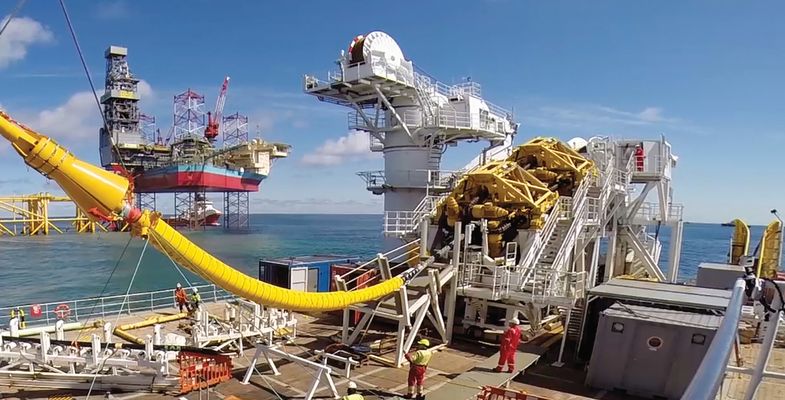IEC 63026 Submarine Power Cable Testing for Offshore Wind
The IEC 63026 standard is specifically designed to ensure the safety, reliability, and efficiency of submarine power cables used in offshore wind energy projects. These cables are critical components that connect turbines on floating platforms with substations on land or other floating structures. The harsh marine environment presents unique challenges that require rigorous testing to meet stringent quality control requirements.
Offshore wind farms are rapidly expanding as a key component of the global transition to renewable energy sources. Submarine power cables must withstand extreme conditions, including water pressure, corrosion, and mechanical stress. IEC 63026 provides comprehensive guidelines for evaluating the performance characteristics of these cables under real-world conditions.
The testing process involves several stages, starting with initial inspection and non-destructive testing (NDT) to ensure that the cable is free from defects. Subsequent tests include tensile strength tests, water tightness checks, insulation resistance measurements, and dielectric strength tests. These tests are conducted using specialized equipment such as tension testers, hydrostatic pressure chambers, and impedance analyzers.
Testing procedures must adhere strictly to IEC 63026 guidelines to ensure accurate results that can be relied upon for compliance purposes. The standard covers not only the physical properties of cables but also their ability to perform under specific environmental conditions. Compliance with this standard is crucial for ensuring safe and reliable operation in offshore wind installations.
The reliability and longevity of submarine power cables are paramount, especially given the remote locations where they operate. Regular monitoring and periodic retesting are essential to maintaining operational integrity over extended periods. By adhering to rigorous testing protocols like those outlined in IEC 63026, operators can ensure that their assets meet all necessary requirements.
In summary, IEC 63026 submarine power cable testing is a critical component of any offshore wind farm project aimed at achieving high standards of safety and performance. This testing ensures that the cables used are capable of withstanding the rigors of marine environments while providing reliable power transmission capabilities essential for successful operations.
Why Choose This Test
- Comprehensive evaluation of cable performance under actual operating conditions
- Identification of potential weaknesses before deployment in critical applications
- Promotion of best practices through adherence to internationally recognized standards
- Enhancement of overall safety and reliability of offshore wind installations
Selecting IEC 63026 submarine power cable testing offers numerous benefits, including enhanced confidence in product quality and reduced risk exposure. By leveraging this service, clients gain access to cutting-edge technology and expert knowledge tailored specifically towards meeting regulatory requirements.
Competitive Advantage and Market Impact
The implementation of IEC 63026 submarine power cable testing provides significant competitive advantages for organizations operating in the offshore wind sector. Here’s how compliance contributes to market success:
- Increased trust among customers who value reliability and safety
- Enhanced reputation as a leader in sustainable energy solutions
- Potential cost savings from reduced failures and extended lifespan of assets
- Improved operational efficiency leading to lower long-term expenses
Achieving certification through rigorous testing not only sets companies apart but also fosters growth by attracting more business opportunities. It demonstrates a commitment to excellence, which is increasingly becoming an expectation across industries.
Why It Matters
The importance of IEC 63026 submarine power cable testing cannot be overstated, particularly in light of increasing investments into renewable energy infrastructure. Ensuring the integrity and reliability of these cables is vital for several reasons:
- Mitigating risks associated with failure during operation
- Guaranteeing adherence to international safety standards
- Reducing downtime through proactive maintenance strategies
- Promoting sustainable practices by minimizing environmental impact
Adequate testing helps prevent costly repairs and replacements, thereby optimizing operational efficiency. Moreover, compliance with relevant standards enhances credibility among stakeholders and reinforces trust within the broader industry ecosystem.





